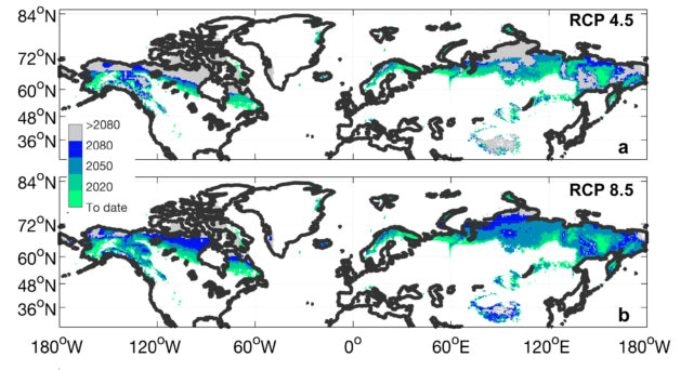Aug 23 2018
In the last few decades, researchers have observed a surge in Arctic plant growth as a cause of climate change. But without observations revealing precisely when and where vegetation has blossomed as the world’s coldest areas warm, it is hard to predict how vegetation will react to future warming. Currently, scientists at the U.S. Department of Energy’s Lawrence Berkeley National Laboratory (Berkeley Lab) and UC Berkeley have formulated a new method that may provide a more accurate representation of Arctic vegetation and Earth’s climate’s recent past - and future.
 Image credit: Trevor Keenan and William Riley/Berkeley Lab
Image credit: Trevor Keenan and William Riley/Berkeley Lab
In a research reported online August 20 in Nature Climate Change, the scientists used satellite images captured over the last 30 years to track - down to a pixel signifying approximately 25 square miles - the ebb and flow of plant growth in cold regions of the northern hemisphere, such as the Arctic region of Canada, Alaska, and the Tibetan Plateau.
The 30-year historic satellite data used in the research were collected by the National Oceanic and Atmospheric Administration’s Advanced Very High Resolution Radiometer. The data was processed by Boston University, and is kept in NEX - the NASA Earth Exchange data archive.
At the start, the satellite data revealed what they anticipated - that as Arctic climates warmed, plant and tree growth increased. After comparing these observations with advanced climate models created for CMIP5 - the Coupled Model Intercomparison Project Phase 5 - what they learned next astonished them.
Their data analysis exposed that 16% of Earth’s vegetated land where plant growth was restricted by cold temperatures thirty years ago is no longer largely temperature-limited today, a result that was not reproduced by the CMIP5 models tested. “Our findings suggest that CMIP5’s predictions may have significantly underestimated changes in the Arctic ecosystem, and climate models will need to be improved to better understand and predict the future of the Arctic,” said first author Trevor Keenan, a faculty scientist in Berkeley Lab’s Earth & Environmental Sciences Area and an assistant professor in UC Berkeley’s Department of Environmental Science, Policy, and Management.
Keenan and Riley used the satellite data to construct a new observational standard that quantifies the growing vastness of vegetated land in the northern hemisphere. They also estimated variations in the proportion of the Earth’s surface where plant growth will no longer be restricted by cold temperatures over the 21st century. Keenan and Riley state that by the year 2100, only 20% of vegetated land in the northern hemisphere will still be restricted by cold conditions that have been the norm there for centuries; the remaining 80% will no longer experience adequately cold temperatures, and with earlier springs, plants will grow sooner, in unanticipated places and to an astonishing degree.
Although the greening might sound like good news as it means more carbon uptake and biomass production, it represents a major disruption to the delicate balance in cold ecosystems. Temperatures will warm sufficiently so that new species of trees could move in and compete with vegetation that had previously dominated the landscape. This change in vegetation would also affect insects and animals that relied on native vegetation for food.
Trevor Keenan, First Author
Researchers working together through the World Climate Research Program created the CMIP5 models to help scientists worldwide gain a better understanding of the connection between carbon emissions and global warming, among other goals. International consortiums such as the IPCC (International Panel on Climate Change) have also applied CMIP5 projections to make informed policy decisions. Keenan said that while the CMIP5 models provided scientists with a wide overview of the problem, they do not always accurately signify the vital roles plants play in reflecting light back into the atmosphere, absorbing carbon dioxide, and conveying water back into the atmosphere.
“No one has looked at high-latitude systems from this angle before as they are very complex, but they’re important as they control multiple feedbacks to the Earth system,” said co-author William Riley, a senior scientist in Berkeley Lab’s Earth & Environmental Sciences Area.
Now that Keenan and Riley have defined a standard approach for evaluating climate models, they plan to investigate how they can use more advanced statistical methods, such as machine learning, to quantify how soil organic matter properties, wildland fires, atmospheric carbon dioxide, and temperature, will influence climate in the 21st century.
The research was sponsored by DOE’s Office of Science. Extra funding was provided by the National Aeronautics and Space Administration.